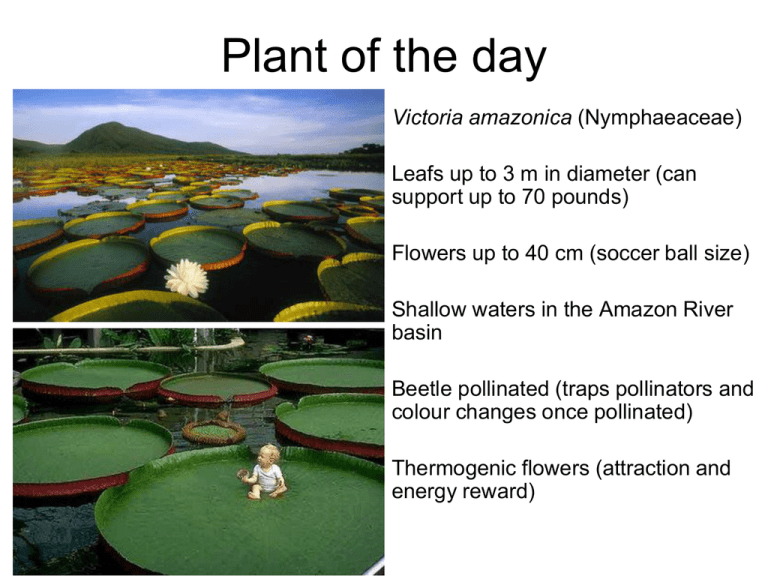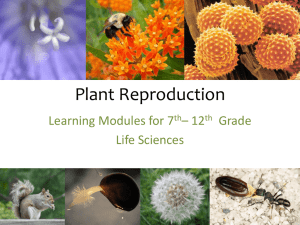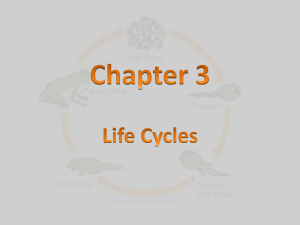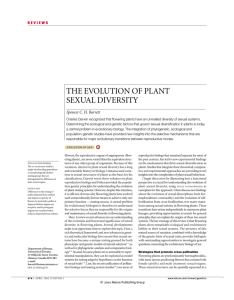
Plant of the day
Victoria amazonica (Nymphaeaceae)
Leafs up to 3 m in diameter (can
support up to 70 pounds)
Flowers up to 40 cm (soccer ball size)
Shallow waters in the Amazon River
basin
Beetle pollinated (traps pollinators and
colour changes once pollinated)
Thermogenic flowers (attraction and
energy reward)
The evolution and maintenance
of plant sexual diversity
Big questions
Why sex?
Why are there two sexes?
Why is there so much sexual diversity in plants versus
animals?
Why do not all plants (and animals) have a mixed mating
system with delayed selfing?
sexual systems
Sexual system: the particular deployment of sexual
structures within and among plants and the physiological
mechanisms governing mating
Sexual interference: conflict in maternal and paternal
functions resulting in gamete wastage and reduced fitness
-physical interference (position of female and male sexual
organs may interfere with efficient pollination)
-pollen clogging of stigmas by self pollen
Examples of plant sexual systems
Dichogamy: differences in the timing of pollen dispersal from
anthers and stigma receptivity of flowers.
•protandry: male phase comes
before the female phase
Claytonia
•protogyny: female phase
comes before the male phase
Which type of dichogamy is the better anti selfing mechanism?
-protogyny
-it guarantees a period of stigma receptivity free from self-pollen
-more protandrous species are self incompatible than protogynous species
Examples of plant sexual systems
Many dichogamous species are also self incompatible. Why?
-may serve to reduce interference between maternal and paternal
functions rather than just preventing selfing and inbreeding depression
Examples of plant sexual systems
Why are larger floral displays beneficial?
Increased pollinator attractiveness
Why are larger floral displays costly?
Geitenogamy (pollen discounting and
selfing)
How do plants resolve this conflict?
Synchronized protandry is one way
Examples of plant sexual systems
Why are larger floral displays beneficial?
Increased pollen attractiveness
Why are larger floral displays costly?
Geitenogamy (pollen discounting and
selfing)
How to plants resolve this conflict?
synchronized protandry is one way
Examples of plant sexual systems
Why are larger floral displays beneficial?
Increased pollen attractiveness
Why are larger floral displays costly?
Geitenogamy (pollen discounting and
selfing)
How to plants resolve this conflict?
Synchronized protandry is one way
Examples of plant sexual systems
Herkogamy: the spatial separation of the anthers
and stigmas within a flower.
Gilia achilleifolia
Approach herkogamy:
stigmas are above the anthers
Reverse herkogamy:
stigmas are below the anthers
Which type of herkogamy would typically be better at preventing self
pollination?
Approach herkogamy - less pollinator mediated intrafloral self pollination
Examples of plant sexual systems
Many herkogamous species are also self incompatible. Why?
-herkogamy may serve to reduce interference between maternal and
paternal functions rather than just preventing selfing and inbreeding
depression
polymorphic sexual systems
The co-occurrence within a
population of morphologically
distinct mating groups
distinguished by differences in
their sexual organs
Dioecy
(separate sexes)
Sagittaria latifolia
Enantiostyly
(mirror image
flowers)
Cyanella alba
Long-styled
Short-styled
Heterostyly
Primula polyneura
Why study polymorphic sexual
Why study plant polymorphic
systems?
sexual systems?
• simple inheritance
• sexual morphs easily identified in
the field
Sagittaria latifolia
• under strong frequencydependent selection
• theoretical models provide
predictions
Cyanella alba
Long-styled
• manipulative experiments
possible
Primula polyneura
Short-styled
The evolution of separate sexes
~ 1/2 of flowering plant families have species with separate
sexes
~6% of species have separate sexes
How do separate sexes evolve from cosexuality?
The evolution of separate sexes
•Gender: is the relative contributions that plants make to the
next generation as a male and female parent (quantitative
measure)
•Monomorphism - continuous variation in gender
•Dimorphism - two distinct sexual morphs that function primarily
as a male or female parent
Androdioecy
Dioecy
Gynodioecy
♀
Sagittaria latifolia
♀
Silene vulgaris
Datisca glomerata
Evolutionary pathways to gender
dimorphism
•Gynodioecy pathway
•Monoecy pathway
Selective mechanisms and the
evolution of separate sexes
The evolution of dioecy from gynodioecy
Nuclear inheritance of male sterility (female)
Females spread if they produce at least two
times as many seeds as hermaphrodites
How might females produce more seeds than
hermaphrodites?
-s* > 0.5 (more than 1/2 the offspring of
hermaphrodites die due to inbreeding depression)
w for invasion
Pollen 1
0
-resource reallocation from male function to female
Seed 1
>2
function (females produce >2x as many ovules)
Cyto-nuclear control of gender
dimorphism
What would happen if the female sterility mutation was in a
mitochondrial gene?
All offspring of the male sterile mutant with be female
Females can spread with only a slight female fertility advantage
Cytoplasmic male sterility in plants is relatively common in nature
The next step to dioecy
In a gynodioecious population hermaphrodites pass on most
of their genes through pollen
Selection for enhanced male function in hermaphrodites can
lead to separate sexes
Selective mechanisms and the
evolution of separate sexes
What factors could lead to increased selfing and the evolution
of dioecy?
Selective mechanisms and the
evolution of separate sexes
Lycium - self incompatibility lost with
chromosome doubling
Polyploids are gender dimorphic
(independent evolution in NA and south
Africa)
Association between polyploidy and
dimorphism also found in 12 unrelated
genera in other families
Miller and Venable 2000
Selective mechanisms and the
evolution of separate sexes
Large plant size (e.g. clonal)->higher selfing rates
Geitonogamy (transfer of self pollen between flowers)
Sagittaria latifolia
Dioecious = large clones
Monecious (hermaphrodites) =
smaller plants
s* > 0.5 in some monecious
populations
Dorken et al 2002
Selective mechanisms
Resource allocation:
•resource poor environments hermaphrodites
unable to maintain both sex functions
•e.g. Wurmbea dioica
•gynodioecy in good environments
•dioecy in poor environments
Floral design and pollen transfer:
heterostyly
Heterostyly: two (distyly) or three (tristyly) style morphs differ in
the reciprocal placement of anthers and stigmas.
•reciprocal sex-organ placement
•heteromorphic
self-incompatibility
(disassortative mating)
•genetic polymorphism
L
S
Floral design and pollen transfer:
heterostyly
How does heterostyly evolve?
Floral design and pollen transfer
Floral design and pollen transfer:
heterostyly
How is heterostyly maintained?
Pollen transfer and equilibrium
morph ratios in typical tristyly
Pollen transfer and equilibrium
morph ratios in typical tristyly
Pollen transfer and equilibrium
morph ratios in typical tristyly
Pollen transfer and equilibrium
morph ratios in typical tristyly
Equilibrium morph frequencies
• Disassortative mating results in negative frequencydependent selection
• Equal morph ratios are predicted
• 1:1:1 found in many tristylous populations
R.A. Fisher
S
L
(1:1:1)
Lythrum salicaria
M
Floral design and pollen transfer:
enantiostyly
Enantiostyly: mirror image flowers in which
the style bends either to the left or the right
side of the floral axis-deposits pollen on the
left or right side of the bee.
Floral design and pollen transfer:
heterostyly
What is the function of monomorphic and dimorphic mirror
image flowers?
Will self pollination be highest in monomorphic, dimorphic or
straight styled populations?
Floral design and pollen transfer
•Created straight styled,
monomorphic and dimorphic
arrays from Solanum rostratum
(monomorphic)
•Highest outcrossing rate in
dimorphic arrays
Jesson and Barrett 2002 Nature
Inter-morph mating
•Most of the mating was
intermorph in the dimorphic array
(negative frequency dependent
selection)
Floral design and pollen transfer
•Herkogamy reduces self pollination (and other forms of
sexual interference)
•Separation reduces precision of cross pollination (lower
male and female fitness-pollen wastage and pollen
limitation)
•Reciprocal herkogamy improves pollen transfer efficiency
•Polymorphisms is generally maintained by disassortative
mating at equal frequency
Unanswered Questions
•Why do dioecious plants have low diversification rates?
•Is the transition from cosexuals to dioecy unidirectional?
•What is the genetic basis of different floral designs such as
heterostyly or enantiostyly? Are they controlled by
supergenes? Is there evidence of balancing selection such
as that found at SI loci?
•Why is SI often found in heterostylous plants but not in
plants with enantiostyly of flexistyly?










